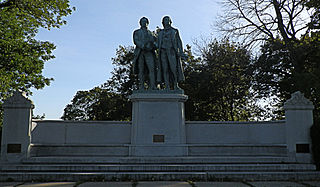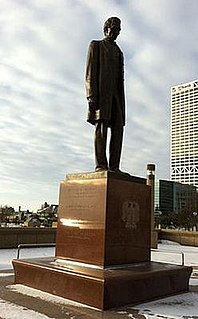Richard Henry Park was an American sculptor who worked in marble and bronze. He was commissioned to do work by the wealthy of the nineteenth century. He also created sculptures for the Chicago World's Fair of 1893.
Sigvald Asbjørnsen was a Norwegian-born American sculptor.

The Victorious Charge is a public artwork by American artist John S. Conway located on the Court of Honor on West Wisconsin Avenue in downtown Milwaukee, Wisconsin, United States. The 1898 bronze sculpture is 9'10" high and sits on a 20' square granite pedestal.
Henry Bergh is a statue by American artist James H. Mahoney located at the Wisconsin Humane Society in Milwaukee, Wisconsin, United States. The bronze statue portrays Henry Bergh, the father of the humane movement in the United States, holding a cane in his proper right hand and petting a dog with a bandaged paw with his proper left hand. It was created in 1891 and stands 9 feet high.

Count Casimir Pulaski is a public artwork by American artist Joseph Kiselewski located in Pulaski Park, which is in Milwaukee, Wisconsin, United States. The bronze statue is a 6-foot, full-length portrait of Count Casimir Pulaski standing atop a 17-foot granite pedestal.

Spirit of Commerce is a public artwork by German artist Gustav Haug located in Jackson Park, which is on the south side of Milwaukee, Wisconsin, United States. This zinc sculpture is 15 feet tall and sits on a red granite pedestal near the park's lagoon. It is the oldest public sculpture in Milwaukee.

The Goethe–Schiller Monument is a public artwork by German artist Ernst Friedrich August Rietschel located in Washington Park, which is in Milwaukee, Wisconsin, United States. The bronze sculpture from 1908 depicts two men, Johann Wolfgang von Goethe and Friedrich von Schiller, one holding a laurel wreath and the other a scroll. The 12 foot artwork rests upon a 26 foot long granite base. The bronze sculpture is a recasting of the statue incorporated into the 1857 Goethe-Schiller Monument in Weimar, Germany.

The Juneau Monument is a public artwork by American artist Richard Henry Park located on the grounds of Juneau Park, which is in Milwaukee, Wisconsin. The base of the statue is made of limestone. On top of the base is a bronze statue of Solomon Juneau. On each side of the base are bronze reliefs. The statue is 5 feet (1.5 m) wide by 15 feet (4.6 m) high.

Leif, the Discoverer is a bronze sculpture of Leif Ericson created by American sculptor Anne Whitney in 1887. It is located at Juneau Park in Milwaukee, Wisconsin, The United States of America.

The Letter Carriers' Monument is a piece of public art by American artist Elliot Offner, located on a triangular plot formed by North 2nd Street, North Plankinton Avenue and West Wells Street in downtown Milwaukee, Wisconsin, in the United States. Created in 1989, the monument depicts three letter carriers and was commissioned in celebration of the centennial of the National Association of Letter Carriers (NALC).

Polyphony is a public artwork by Austrian artist Egon Weiner located on the University of Wisconsin–Milwaukee campus, which is in Milwaukee, Wisconsin, United States.

Eight Stone Lions is a set of Bedford limestone or sandstone sculptures by Paul Kupper (?-1908) located in Lake Park in Milwaukee, Wisconsin, United States.

Abraham Lincoln is a public artwork by American artist Gaetano Cecere located on Lincoln Memorial Drive in Milwaukee, Wisconsin, United States. The 10'6" bronze sculpture depicts a young beardless Abraham Lincoln. The former president stands looking down with both hands at his sides.

The Washington Monument is a public artwork by American artist Richard Henry Park located on the Court of Honor in front of the Milwaukee Public Library Central Library, which is near Marquette University in Milwaukee, Wisconsin. The bronze sculpture is a full-length portrait of a 43-year-old George Washington, and stands on a granite pedestal; a bronze woman points up at Washington while a child, also made out of bronze, gazes upward. It was sculpted by Richard Henry Park and was erected in 1885 with philanthropic financial support from Elizabeth Plankinton. The statue was restored 2016-2018.

The R. D. Whitehead Monument is a public artwork by Norwegian born American artist Sigvald Asbjornsen located on the south side of Milwaukee, Wisconsin, United States. The artwork consists of a bronze-relief plaque depicting a dog and horse, set on a granite pillar, which is in turn part of a fountain.

Immigrant Mother is a public artwork by Croatian artist Ivan Meštrović located in Cathedral Square Park in Milwaukee, Wisconsin, United States. The bronze sculpture sits on a red granite base and depicts a mother with her children.

The Lapham Memorial is a public artwork by American artist Albert H. Atkins, located near the entrance to Lapham Hall, on the University of Wisconsin–Milwaukee campus. It is in memory of Increase A. Lapham, a 19th-century scientist famous for prompting the creation of the National Weather Service and recording the antiquities of Wisconsin, among other accomplishments.

General Douglas MacArthur is a public artwork by American artist Robert L. Dean, a 1953 graduate of the United States Military Academy. Previously, the statue was located in MacArthur Square in the Milwaukee Civic Center Plaza, downtown Milwaukee, Wisconsin, USA. On June 7, 2014, it was relocated to its new waterfront location at Veterans' Park, next to the Milwaukee County War Memorial Center. With full military honors, the bronze statue of General Douglas MacArthur was rededicated at its new home on June 7, 2014. The ceremony was the capstone event for the MacArthur Memorial Week, held nearly 35 years after the statue's original dedication on June 8, 1979.

The Mahatma Gandhi Memorial is a public sculpture by Gautam Pal located at the Milwaukee County Courthouse in downtown Milwaukee, Wisconsin.
Sculptor Aloys Loeher (1850–1904) was an American sculptor. He created a signature piece which was exhibited at the 1893 Columbian Exposition. Among his other works are the Siegfried Monument in New York, the Fritz Reuter Monument in Chicago, and a number of medals and busts.
























